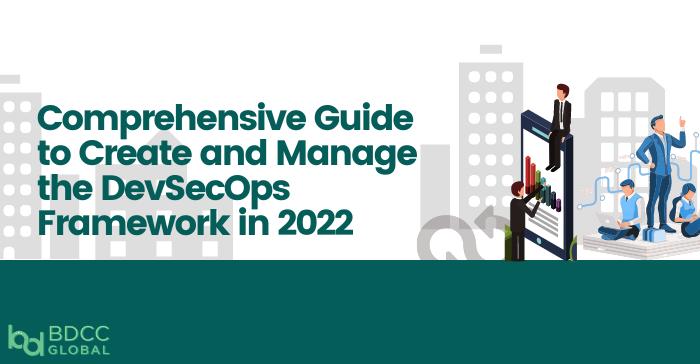
Executing DevOps is indeed an imperative activity that you have undertaken for the growth of your organization. With correct implementation, it ought to revolutionize your company by developing communications between teams, increasing the pace of marketing, boosting overall productivity, and increasing customer satisfaction as well. But, all of these would be futile if security is not prioritized. This is exactly where the DevSecOps framework comes into play with its eminent security tools and techniques.
This technology ensures that there is continuous protection offered throughout the workflow. Let us learn how you can create the ideal framework and continue to maintain it.
The DevSecOps framework acts as the guard, safeguarding your organization from endless security breaches.
Details About Creating a DevSecOps Framework
DevSecOps is a continuation of the prevalent software development practices, therefore, it is most suitable to create the DevSecOps framework adhering to the Agile approach to deciding, coding, examining, deploying, and ongoing operations. The creation can be broken down into certain parts:
Decision-Making and Development
It is in the initial days of designing and arranging that the need for DevSecOps security arises. This can be understood by understanding how security considerations can affect goal setting. It is extremely vital to give importance to concise and strategic planning and doesn’t only mean trivial feature-focused elaborations. It means, the inclusion of user blueprints, acceptance test parameters, threat models, and so on.
The second step of the management with DevSecOps calls for the development or expansion of the framework. The teams are required to begin analyzing the maturity of the prevalent practices. It is always ideal to accumulate resources from diverse sources to offer guidance. Developing a code review structure at this stage might also offer benefits since it uplifts uniformity which is an integral feature of the DevSecOps framework.
Construction and Trialling of the DevSecOps Framework
In this step of the development cycle DevSecOps, the automated tools majorly do the work. These are tools whose build script turns the source code into machine code. Through automation tools, you will enjoy quite a lot of robust features. Not only do they have a substantial library of plugins, but also numerous available UIs. Some also unquestionably detect any weak library and supersede it with fresh ones.
In the fourth step of the undertaking of the DevSecOps security framework, the aforementioned built-ups are tested. Here, you need to assess the proficiency of the sturdy automated testing framework that revolves around robust testing procedures in the pipeline.
Positioning and Operations
The positioning or deployment of the framework is laid out with the help of IaC or Infrastructure as a piece of Code equipment. This equipment works by automating the procedure and gearing up the pace of the software delivery.
On the other hand, operations behold significance as well. Recurring assessment is a task of the operations team. The zero-day exploits are quite scary, therefore, the operations team checks on them continuously. Management with DevSecOps results in more convenience since IaC equipment is used for acquiring the organization’s infrastructure rapidly and efficiently.
Observing and Scaling
Success cannot be achieved by your organization if there is no indulgence in robust, continuous, and efficient monitoring tools. It is through them, a stringent security system is assured, eventually leading to a foolproof system as well.
Coming to scaling, plays an equally significant role in the evolution of this framework. With the foundation of virtualization, organizations can completely do away with resources for maintaining massive data centers. Instead, in the rise of any threats, they can accelerate the infrastructure for handling the same.
What are the Top Practices for DevSecOps Framework Maintenance?
Apart from following the right way to implement the framework, the development cycle DevSecOps demands maintenance of its efficacy by ensuring certain practices.
1. Focus on Secure Coding: When you are emphasizing on secure coding you are simultaneously welcoming a high-resistant software guarding all the loopholes. Failing to follow this practice might result in numerous software security risks.
2. Welcoming Automation: For matching the speed of the security with the code delivery in the CI/CD environment, automation is vital. Automation is required to ensure a trouble-free system mostly in MNCs or big organizations where tonnes of codes are produced each day.
3. Shift Left: This testing approach can be described as the process of introducing security right at the beginning of the application making instead of holding back till the eventual stages of the delivery chain.
The DevSecOps framework holds immense significance for any organization since it builds the fundamental security system. It is a known fact that security breaches are on the rise, and even a minute infringement can cost a huge sum. The sad part is, till now, numerous organizations are unaware of the power of this framework, let alone implementing it. But it is never too late to initiate something fruitful, therefore, start today. Understand the framework thoroughly and how it will benefit your organization in diverse ways.
BDCC
Latest posts by BDCC (see all)
- Cloud computing in healthcare: Uses and benefits - June 23, 2025
- What are the Best Practices for Terraform File Structure? - June 10, 2025
- From Monolith to Microservices: DevOps Strategies For a Smooth Transition - June 5, 2025

